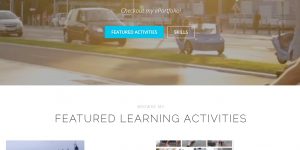This Faculty of Arts project aimed to:
"support student learning by developing the foundation and supportive environment that are necessary for students to systematically reflect on their learning throughout their university experience, supporting their development as experts in their field and enabling them to make connections between their expertise and life path."
It argued that the students could only be empowered to imagine their career pathways if they are trained to weave together their curricular and extra-curricular learning experiences and reflect on their expertise and competencies.
Originally, one objective and arm of the project involved working with programs and instructors to incorporate eportfolios within, and sometimes across, courses. The initial attempts involved a few course learning activities translated so they could be 'submitted' as a portfolio. The portfolios were created in the UBC Blogs (plain Wordpress) platform or on commercial site creation tools like Wix or Squarespace.
Many students found the technology challenging because these tools create blogs or websites, not portfolios per se. Few students added anything more than they were required to include, and the final products were mostly underwhelming. Some successes were observed in Geographic Information Systems courses and in the Bachelor of Media Studies, where, in both cases, students work was well suited to a hyperlinked and multimedia format.
Training was offered for students and instructors, but take-up was slow and faced a number of challenges. A better technology solution was required to solve the three problems:
- Faculty and, more importantly, programs' reluctance to incorporate eportfolios in curriculum.
- Technological barriers to student engagement with their eportfolio.
- Students unable to differentiate this from a personal, outward-facing website.
Students' perceptions that this was something for one or two courses only, rather than a start of a lifelong practice of reflection, integration, and showcasing of learning.
Materials
- UBC TLEF Story on the project with reference material.
- Arts ISIT Support page for Faculty with tools and benefits.
NEXT: Rationale for Eportfolios

The project made it clear that there is a tension between, on the one hand, encouraging population of eportfolios by having them a mandatory assignment in a class, and on the other hand, student 'ownership' of the portfolio as a tool they use independently to make sense of all their curricular and extra-curricular learning experiences.
It was also surprising how important ease-of-use of technology is for students. They need something that looks and feels easy and modern.